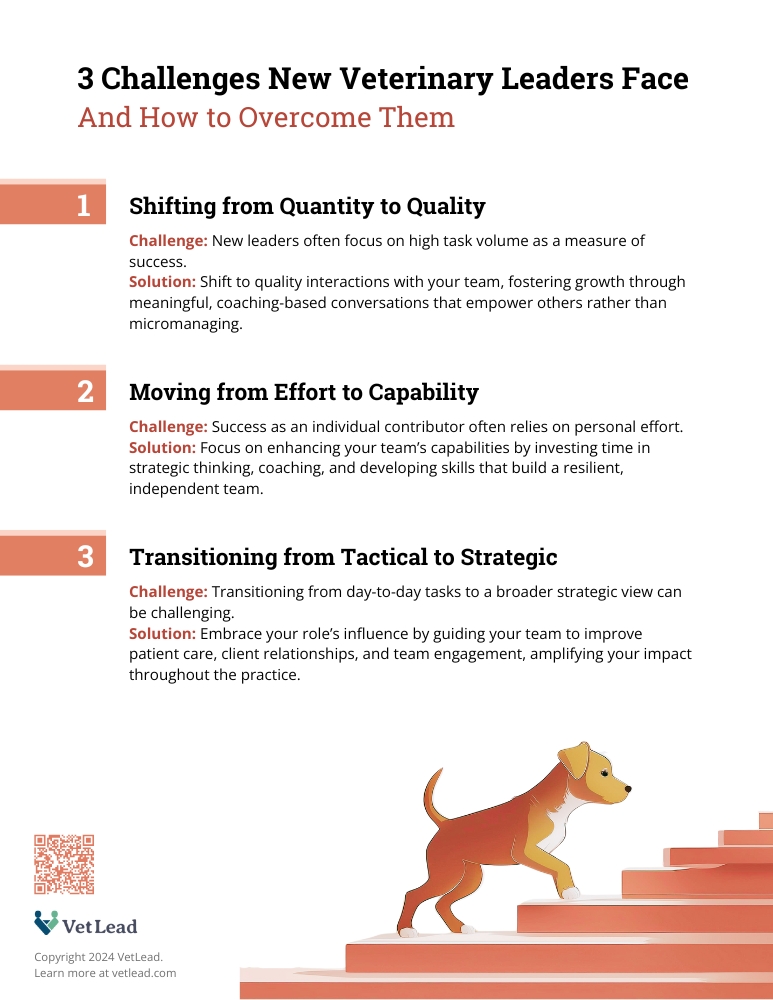Feeling overwhelmed as a new leader in your veterinary practice? You're not alone. Many new leaders face common challenges when transitioning from individual contributor to management roles.
Strong leadership affects every aspect of a practice—from the quality of patient care to team morale and client satisfaction. Strong leadership is essential for creating a thriving practice where team members feel valued, engaged, and motivated to provide exceptional patient care. This makes leader development - and understanding its challenges - critical for any veterinary practice striving for long-term success.
Transitioning From Contributor to Veterinary Leader
One of the most important phases of leader development in a veterinary clinic is the transition from individual contributor—like a veterinarian, technician, or assistant—to a leadership or management role. When practices get this part right, they address one of the most common failure points in leadership development.
The transition isn't easy. Often, the people selected for a leadership role excelled at individual tasks, such as medical procedures, client communications, or technical skills. While this experience is valuable, the leap into leadership requires a different set of strengths and an entirely new approach to work.
The Veterinary Leadership Program
Kicking off January 2025
Get info on this exclusive program.
Learn how to:
- 1Build an accountable team
- 2Make change happen
- 3Improve performance
- 4Hire exceptional talent
Includes live coaching.
Investment will be $897 per person
Excelling as an individual contributor requires skills that need to shift or expand to make the transition to leadership effective. Here are a few of the biggest challenges faced by those making that leap in veterinary practices:
1. Shifting from Quantity to Quality
In many cases, individual contributors need to shift from focusing on the number of tasks completed to the quality of those tasks. As a veterinarian or technician, this might involve:
- The number of patients seen
- Treatments administered
- Follow-up calls completed
While quality is always essential, frequency and speed can often determine individual success.
Effective Communication for Veterinary Leaders
In a leadership role, however, simply doing more—whether it's more client conversations or more team meetings—can easily lead to micromanagement and frustration. Great leaders know how to make each interaction count. For instance, instead of giving constant instructions to the team, veterinary leaders can focus on coaching and effective communication skills to achieve better results with fewer, more meaningful conversations. The goal is to develop the team's capabilities so that less time is spent fixing issues, redoing tasks, or intervening in daily operations.
2. Shifting from Effort to Capability

As an individual contributor, putting in more hours or increasing the intensity of your efforts often leads to better results—whether that means seeing more patients, completing more surgical procedures, or handling more client calls. But in a leadership position, success isn't solely tied to effort.
Enhancing Your Veterinary Team’s Capabilities
As a leader, it’s important to enhance the team's capabilities rather than trying to do more yourself. This means improving your ability to listen, learn, strategize, communicate, and coach. It involves spending time thinking strategically about how to solve challenges, asking insightful questions, and planning for long-term success in the practice. While effort definitely plays a role, true success as a leader is about insight, exploration, and development, both of yourself and your team.
3. Shifting from Tactical to Strategic
Veterinary leaders must transition from focusing on day-to-day tasks to taking a broader, strategic view. Instead of concentrating solely on completing this week's appointments or managing today’s client issues, leaders need to think about building a thriving team, improving patient care processes, and enhancing the client experience over the long term.
Increasing Your Strategic Influence
Your span of direct control decreases as you move into leadership, but your span of influence increases. You may no longer be the one directly interacting with every client or patient, but you can influence those interactions by coaching your team effectively. If done well, your impact multiplies—resulting in better patient care, improved client relationships, and a more engaged veterinary team.

Download this Supporting PDF Now
Share it with leaders and teams. No email address required.
Developing Your Veterinary Leadership Potential
As a new leader in a veterinary practice, navigating the shift from individual contributor to a strategic leader can be challenging. By understanding and overcoming the hurdles outlined in this post—shifting from quantity to quality, effort to capability, and tactical to strategic thinking—you can unlock your full potential as a leader and create a thriving environment for your team.
Ready to further develop your leadership skills and make a lasting impact on your veterinary practice? Learn more about the Veterinary Leadership Program and discover how it can empower you to build a stronger, more successful team.
What challenges did you face as a new veterinary leader? Share your experiences in the comments below.
